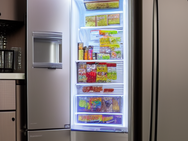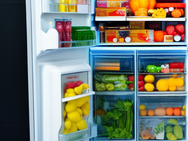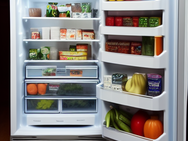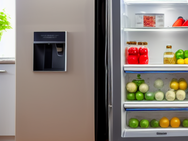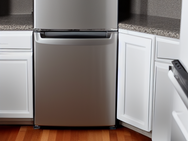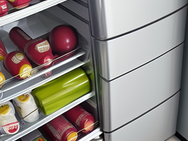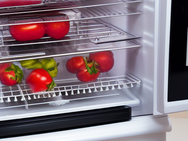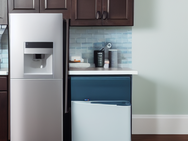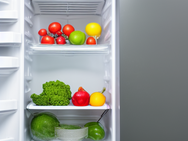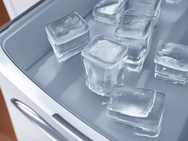Fridge defrost drain problems?
Many people don't realize the importance of the defrost drain in their fridge until it becomes clogged. The defrost drain allows excess condensation, or water, to escape during the defrost cycle. When this freezing defrosts drain becomes clogged, that water can build up and lead to problems with the fridge's operation, such as leaking or icing. Not only can this damage your fridge and its contents, but it can also be a costly repair. Fortunately, keeping the defrost drain clear is easy and can prevent major issues down the line. Make sure to regularly clean out any gunk or debris that may be blocking the drain, and consider using a solution like vinegar or baking soda to break up stubborn buildup. Taking care of your defrost drain now can save you time and money in the future.
Have you ever opened up your freezer temperature indicator and found a large pool of water inside? Chances are, your refrigerator defrosts drain pan is blocked. The defrost drain is a small tube in the back or bottom of your fridge that helps to remove excess water during the defrost cycle. When this tube becomes clogged with ice or debris, the water has nowhere to go and may end up leaking onto your floor. It's important to regularly clean out the defrost heater drain to prevent damage and costly repairs. Fortunately, it's easy to do and only requires a little hot water and vinegar to dissolve any stubborn buildup. Cleaning out you're defrost drain regularly will help keep your fridge functioning smoothly.
How do you know if the defrost drain is clogged?
If your refrigerator's drainage system is clogged, it can cause a lot of problems. The first sign may be excessive ice buildup in the freezer, as the water has nowhere to go during the defrost cycle. You may also notice pools of water forming underneath or around the fridge. Another tell-tale sign is a strange odor coming from the appliance, as mold and bacteria can build up in standing water. Fortunately, fixing a clogged defrost drain strap is a fairly straightforward task for a fridge repair technician. They will remove any blockages and ensure that everything is flowing smoothly again. Keep an eye out for these warning signs and schedule maintenance before the issue becomes too severe.
Fridge repair can be a daunting task, but knowing the signs of a clogged defrost drain can save you time and money. If your fridge is leaking water or producing excessive ice, it could be a sign that your defrost drain is clogged. Another indicator is if your food is not staying cold enough or if the inside of your fridge has an unpleasant odor. Fortunately, fixing a clogged defrost drain is relatively simple. To start, locate the freezer drain and make sure it's not just frozen over by gently melting any ice with warm water or a hairdryer. Then, clear away any debris blocking the drain using hot water and vinegar or a pipe cleaner. If these steps do not fix the problem, be sure to contact a professional for assistance. Taking care of a potential clog early on can ensure that your fridge continues running smoothly.
How do you unclog a defrost drain?
Fridge repair can be overwhelming, especially when unexpected issues arise. One common problem is a clogged defrost drain. This can cause water to build up in the bottom of your fridge and lead to mold growth or ice buildup. The good news is that unclogging this drain is often a simple fix. First, locate the defrost drain by consulting your fridge's manual or doing a visual inspection. Once you've located the drain, pour boiling water down the drain to melt any ice buildup and use a bent wire or pipe cleaner to remove any debris blocking the drain. As a preventive measure, periodically pour vinegar down the defrost drain to keep it clear of debris and running smoothly. With some simple maintenance, you can avoid major issues with your defrost drain in the future.
Fridge repairs can be a daunting task, but unclogging a defrost drain is relatively simple. First, locate the drain, which can typically be found at the back of the fridge near the bottom. Use hot water and soap to clean it out, or if necessary coil a wire hanger to remove any debris. You can also try pouring white vinegar or baking soda and boiling water down the drain to break up any stubborn clogs. If these methods don't work, you may need to replace the drain entirely for optimum function. However, taking these steps will often successfully unclog a defrost drain and keep your fridge working smoothly.
What are some common causes of clogged defrost drains?
Fridge defrost drains are often taken for granted until they become clogged, leading to potential water damage to the appliance. Common causes of clogged defrost drains include frozen drain lines and food debris buildup. The drain line can freeze over time due to decreased airflow or reduced temperatures in the fridge. Food scraps and other debris can also accumulate in the drain, leading to blockages. Thankfully, these issues can often be easily fixed with a bit of DIY fridge repair. First, try thawing out any frozen areas with hot water or a hairdryer. Then, clean out any food debris using a mixture of warm water and vinegar or baking soda. Of course, if you suspect more serious problems with your fridge, it's always best to call in a professional for repairs. Keeping an eye on your defrost drain can save you from headaches in the long run.
One common cause of a clogged defrost drain is build-up in the drain tube itself. Food particles, mold, and bacteria can get trapped in the tube and block the flow of water. Another potential issue is an issue with the defrost timer or thermostat, resulting in excess ice buildup in the drain. Lastly, a clogged filter or drainage pan can also lead to problems with the defrost drain. Fortunately, many of these issues can be easily fixed by a refrigerator repair technician. However, it's important to schedule regular maintenance for your fridge to prevent issues such as clogged drains from occurring in the first place. By keeping an eye on your defrost system and ensuring all parts are functioning properly, you can avoid inconvenient--and potentially expensive--repairs down the line.
What are some common symptoms of a clogged defrost drain?
Have you ever noticed your fridge getting unusually hot or forming pools of water on the floor? These could be signs of a clogged defrost drain. This small part plays an important role in evaporating the excess water that builds up during the defrost cycle. If it becomes clogged, however, things can quickly go downhill. In addition to the above-mentioned issues, a clogged drain can also lead to ice buildup within the freezer and strange odors coming from your fridge. Luckily, this issue is usually easy to spot and solve with regular cleaning and maintenance. Still, if problems persist it may be time to call in a professional fridge repair service. Don't let a clogged defrost drain ruin your appliance - stay proactive and keep an eye out for these symptoms!
Fridge repair often becomes necessary when ice builds up around the edges of the freezer and water pools beneath the vegetable crisper. These symptoms indicate that the defrost drain is clogged. As the temperature in the freezer drops, water from defrosting ice accumulates in a drainage tube. A blocked tube can cause this water to overflow onto the floor of your fridge, leading to a mess and potentially causing damage to food or electrical components. Another common symptom of a clogged defrost drain is a pool of water underneath or around the fridge itself. This leakage occurs because excess water has no way to escape and will eventually find its way out through any potential crevices. Fortunately, a blocked defrost drain can usually be easily fixed by unclogging the tube with warm water or bleach. However, if these measures fail, it may be time to call in a professional refrigerator repair person. Taking care of this issue promptly can prevent further damage and restore your fridge's efficiency.
How can you prevent your fridge from leaking water in the future?
Fridge water leaks can be a headache to clean up, not to mention costly if they damage surrounding appliances or floors. Luckily, there are steps you can take to prevent future leaks. First, make sure your fridge is properly leveled. An uneven fridge can cause a buildup of ice in the freezer, leading to water leakage. Second, check and clean the drip pan periodically. The drip pan collects excess water from defrosting and should be emptied regularly to prevent overflow. And finally, schedule regular maintenance with a technician for your appliance; they can detect and fix any small issues before they become bigger problems down the road. By taking these preventive measures, you can avoid the hassle and expense of dealing with leaking water in your fridge.
Fridge leaks can not only cause damage to your floor and surrounding area, but it can also lead to a higher electricity bill and poor performance from your appliance. So, how can you prevent these leaks from happening in the future? One of the most common causes of fridge leaks is a clogged defrost drain, so regularly cleaning the drain can help to prevent any blockages. Additionally, checking the seals on your fridge's doors regularly for cracks or wear can ensure that cool air stays inside and doesn't cause excess condensation, which can lead to leaks. And lastly, scheduling regular maintenance with a certified technician can help identify and fix any potential problems before they lead to leaks. By taking these precautions, you can ensure that your fridge stays leak-free.
ProMaster Appliance Repair
When it comes to appliance repair, ProMaster has a reputation for being the best in the industry. Their technicians are highly trained and experienced, able to quickly diagnose and fix any problem with any make or model of appliance. ProMaster also offers competitive prices and a satisfaction guarantee, so you can trust that you're getting exceptional value for your money. Plus, ProMaster prides itself on their outstanding customer service, making the whole experience as hassle-free as possible. So when you're looking for reliable appliance repair, trust ProMaster to get the job done right.
Conclusion
If you're experiencing water leakage from your fridge, the first step is to determine the source of the problem. This may be as easy as unclogging a blocked defrost drain with warm water or bleach, but if these measures fail it's time to call in a professional refrigerator repair person. Taking care of this issue promptly can prevent further damage and restore your fridge's efficiency. Additionally, there are steps you can take to prevent future leaks, such as checking the seals on your fridge doors regularly for cracks or wear, cleaning the drip pan periodically, and scheduling regular maintenance with a technician. By taking these preventive measures, you can avoid the hassle and expense of dealing with leaked water in your fridge. For reliable appliance repair service that will get the job done right, trust ProMaster Appliance Repair.

Tell the code "DC25" and get a discount of $25
The discount applies only to repair services

